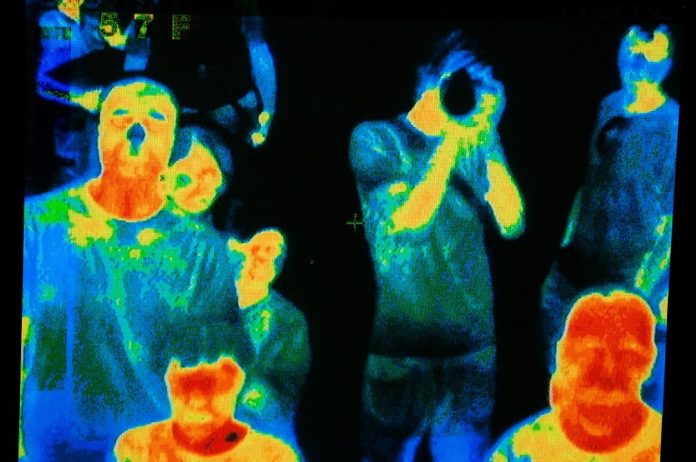Thermal body temperature cameras are being enlisted to assist in the battle against the COVID-19 epidemic, with government, commercial and industrial end users eager to implement BTM technology in order to detect elevated body temperatures that may indicate fever.
THERMAL body temperature cameras can’t detect a virus, but they can detect elevated body temperatures in public and private spaces in a rapid, non-invasive way, alerting security and healthcare teams to the need to test scanned subjects for illness in a way that does not slow foot traffic.
But before we go further, BTM devices now need to attain Australia’s Therapeutic Goods Administration listing as Class IIa devices, which is the same classification as hands-free digital thermometers – check this TGA link as part of your considerations. It matters not that very few digital thermometers available for sale in Australia are actually TGA-listed – you’ll still need make sure your BTM system is TGA-classified.
There are challenges. Operationally, it’s important that BTM cameras can see the forehead or corner of the eye – that means no hats or glasses can be worn – and BTM cameras should be placed no more than 2 metres away from subjects. Security teams must also be sure the environment has no strong light sources, sunlight or people not being tested in it. Further, people who are asymptomatic – that might include a large number where COVID-19 is concerned – may not show an elevated temperature.
Because these cameras are measuring skin temperature, not core temperature, expect false positives and integrate this expectation into procedures. Also, be sure the display mechanism is sufficiently subtle to show slight temperature differences.
Controlling the environment is vital – you need temperatures between 18-24 degrees and make sure the equipment you select has a noise equivalent temperature difference of 50mK – that’s 0.05C – and a spectral range between 7.5 and 13 microns. You also want low latency in the image stream and higher resolutions. The standard relating to the use of thermographic cameras is ISO 13154 – make sure you’re across it before you apply this technology to your site.
Be aware BTM camera ‘thermometers’, which have generally been designed and manufactured to check temperatures of plant equipment or warm bodies against a cold external background, are not a magic bullet for virus detection. When it comes to COVID-19 detection, only a proper medical test can establish infection. What this means is that BTM camera stations must be supported by proper medical procedures that can swing into action to assist subjects with professional medical assistance immediately after elevated temperatures have been detected.
Some BTM cameras available include Dahua’s PoE DH-TPC-BF3221-T thermal network hybrid bullet camera. This camera features 256 x 192-pixel VOx uncooled thermal sensor technology, a focus free thermal lens with a focal length of 7mm and an operating distance of 3 metres, body temperature measurement with an accuracy of ±0.3C, with an adjacent black body, which is vital for correct calibration. The camera includes a 1/2.8-inch 2MP progressive scan Sony CMOS, region of interest, motion detection and colour palettes, active deterrence with white light and siren, 2 alarm inputs and outputs, MicroSD memory and IP67 rating.

Another option is the BTM-T5 body temperature detection camera, which is a human body temperature measuring and screening system suitable for areas where there are large groups of people. This IP66-rated thermal camera has a 384 x 288-pixel IR detector with a temperature measurement range of 0C to 60C and a measurement accuracy of ≤ 0.3C that’s ideal for fever screening programmes.

The BTM-T5 comes with a range of temperature measurement tools which includes motion detection and alarm I/O, temperature alarm and many more. The BTM-T5 allows non-invasive fever screening to take place meaning there is no major disruptions to the flow of people in an area. The BTM-T5 has an uncooled IRFPA microbolometer detector with an 8mm fixed lens, while the optical camera has a resolution of 2MP and features a 2.7mm to 12mm motorised lens, H.265, H.264, and MJPEG codecs, 120dB of WDR and simultaneous access for 10 users.
Another option is Uniview’s dual-view infrared USS-TIC-500 series dual-spectrum infrared body temperature rapid screening instrument. It uses a non-refrigerated core and low signal-noise image processing technology and is a non-contact, real-time, continuous and accurate temperature measuring system. Software visually displays the temperature information of subjects in the field of view, making it ideal for entry-exit points.

Key features of the USS-TIC-500 include 384 x 288 pixel sensor, body temperature detection with abnormal temperature alarm, automatic exposure control and automatic white balance, face temperature measurement mode that intelligently analyzes face targets and measures body temperature, support for multiple alarm linkages, dual-light temperature measurement linkage, and the ability to draw regular and superimposed temperature measurement information on a standard optical image for easier monitoring in real time.

UNV face recognition and temperature measurement terminal.
Another option is UNV’s temperature measurement face recognition terminals, which combine face recognition and temperature measurement. UNV’s temperature measurement face recognition terminal adopts non-contact temperature measurement to prevent cross infection and ensure safety.
The terminal measures up to 30 people per minute and an audio alarm will be triggered if the target temperature is higher than the set threshold. Staff not wearing a mask or whose faces can’t be detected can be set to trigger a voice alarm to assist security and management to react.

Hikvision’s new range of thermographic cameras and handheld devices provide a non-contact and highly efficient way to measure body temperature. With advanced algorithms, these thermographic cameras can detect elevated body temperatures in moving crowds such as passengers, commuters and shoppers, with an accuracy of ±0.5 degrees celsius. The cameras include AI human body detection which allows the user to fix the measurement areas to human bodies, reducing false alarms. They also have embedded audio alarms, which can trigger other alarms to notify operators when a person with a fever passes by.
#securityelectronicsandnetworks.com











